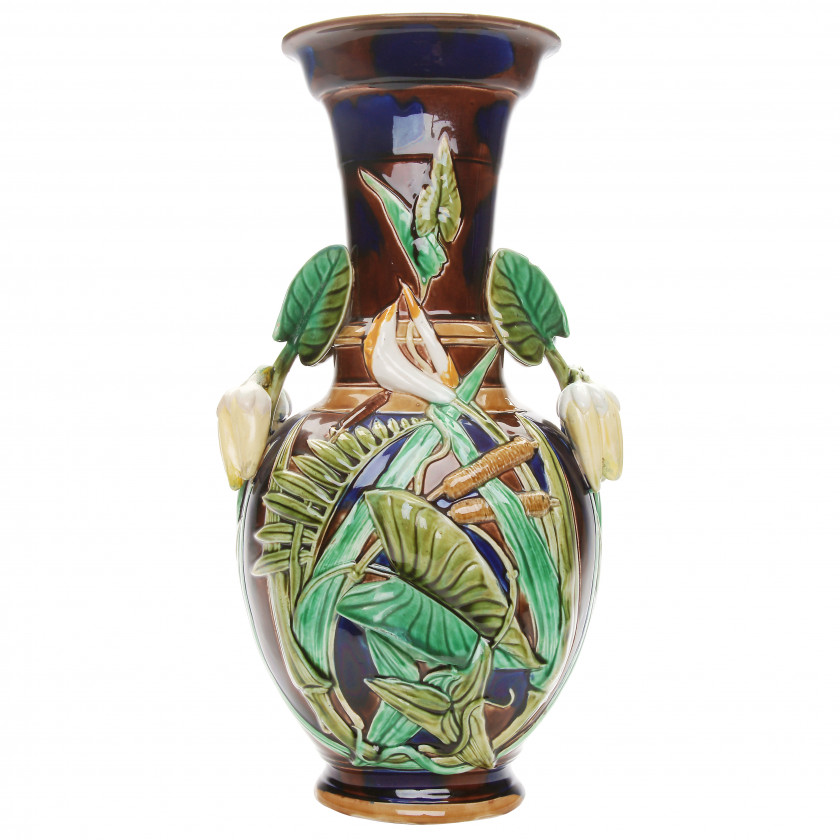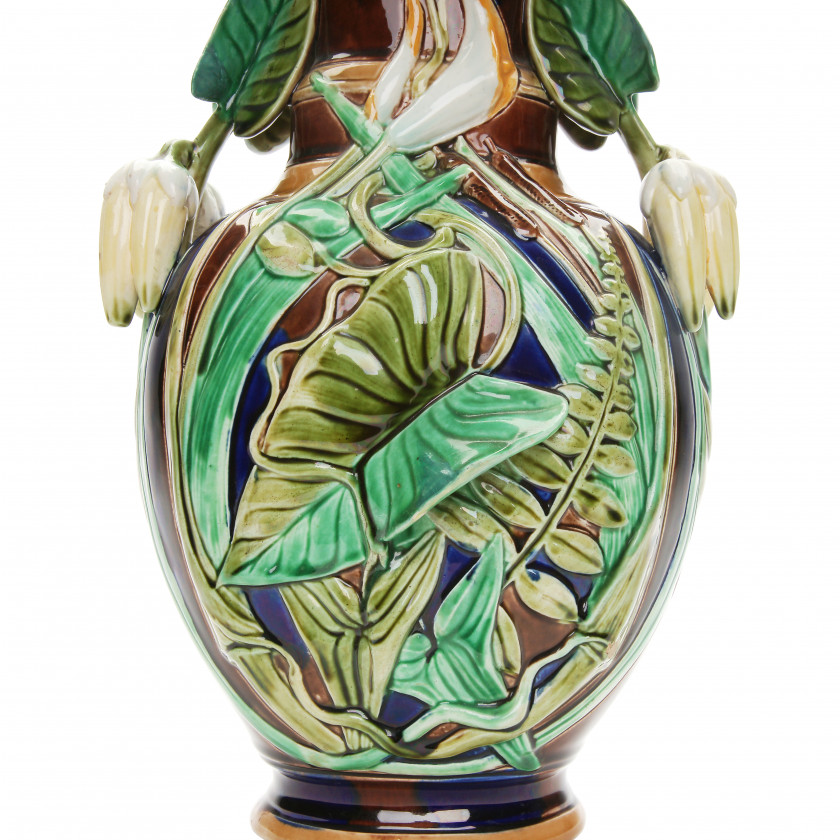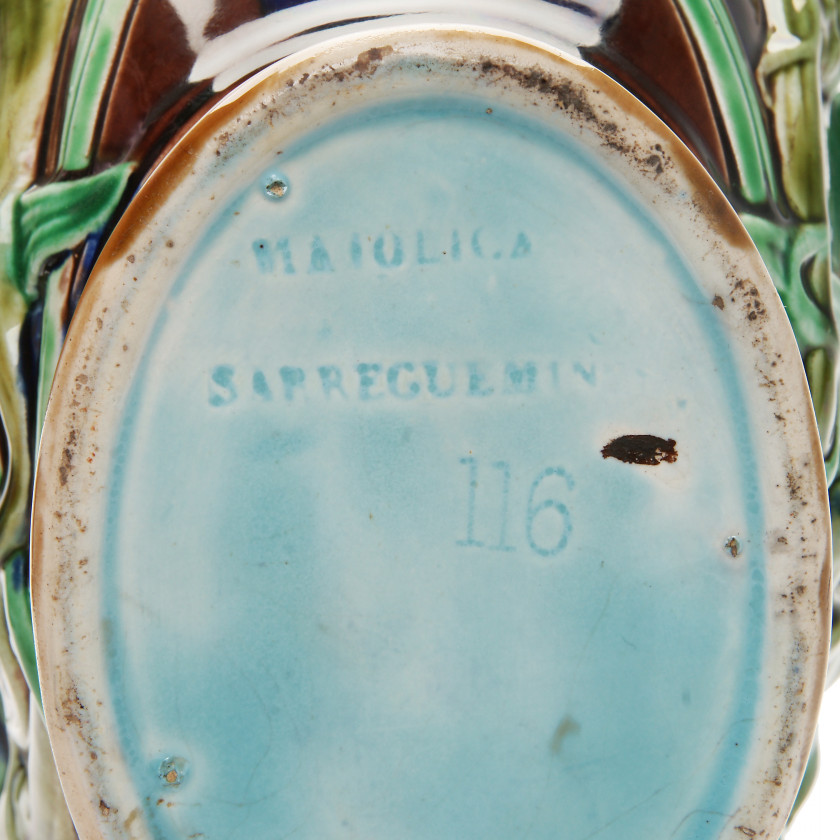Faience vase in Art Nouveau style
-
900.00 EUR
Artist/Maker: Sarreguemines
Artist/Maker Dates: 1790 - 2007
Place of Production: France
Date of Production: end of 19th century
Materials: faience, underglaze hand painting
Style: Art Nouveau
Model Nr.: 116
Height: 43.0 cm.
Condition:
Condition notes: Chips, Restored
Description
The reputation of the faience of Sarreguemines requires no further endorsement. In two centuries time the small family venture, established during the Revolution, has gone a long way. Admirers of the lively and colourful pieces can be found all over the world. Paul Utzschneider and Paul de Geiger, real artists, have brought the small city to the top of the earthenware industry: from the 19th century Sarreguemines has provided the whole world with a vast collection of earthenware, vases, decorative flower pots, wall frescos, chimneys, and so on.
Activities commenced in 1790. Nicolas-Henri Jacobi and two partners set up the first factory, despite the rather unfavourable economic situation. Jacobi bought an oil mill which lay alongside the river, transforming it into a pavement factory.
His good intentions, however, were not enough: the difficult supply of raw material, the hostile attitude of the inhabitants, the intense competition between English and French factories and the unrest due to the Revolution forced Jacobi to give up his position.
Paul Utzschneider and the beginning of the expansion
This young man from Bavaria took over the factory in 1800 and soon business quickly picked up again. Napoleon I became one of his major customers and placed several orders with him. The factory supplied most of the original tiles used to decorate the walls of the Paris metro during its construction.
Utzschneider, an ingenious young man, introduced new decorating techniques. The expansion was such that he had to open new workshops. He therefore acquired several mills. Protests expressed against deforestation result in a switch from heating with wood to heating with coal, but the first coal ovens were not built before 1830.
Industrialisation
In 1836 Utschneider left the management of the factory to his son-in-law, Alexandre de Geiger. The latter constructed new buildings which harmonised very well with the landscape. The Moulin de la Blies was built in this spirit. In 1838 Alexandre de Geiger was approached by Villeroy & Boch. This cooperation resulted in increased business. The industrial revolution blossomed. A new kind of architecture made its appearance with the introduction of saw tooth roofs and high chimneys to prevent smoke falling on adjoining houses. The new factories, built in 1853 and 1860, were solely steam powered. Inside the workshops the modernisation was mainly aimed at energy provision for the machines.
Consolidation and the transition to the new century
In 1871, due to the annexation of the Mosselle by Germany, Alexandre de Geiger left Sarreguemines and moved to Paris. His son, Paul de Geiger, took over the management. Two new factories were built in Digoin and in Vitry-le-François. Paul de Geiger died in 1913, the same year when the company Utzschnieder & Co was split in two ventures: one managed the factory of Sarreguemines, the other one the French factories (Digoin and Vitry-le-François). In 1919, after the first world war, the different factories are joined together under the name Sarreguemines-Digoin-Vitry-le-François and are managed by the Cazal family. During the Second World War the factory was seized from 1942 until 1945 during which time it was managed by Villeroy & Boch.
At the beginning of the 20th century, the Sarreguemines factory - specialised in the production of ceramic tiles - benefited from the artistic input of artists such as H. Steinlein. They were commissioned to design decorative panels mainly used in department stores, shops and buildings entrance halls.
The Lunéville years
In 1978, the group Lunéville-Badonviller-Saint-Clément bought the factory. This was a decisive factor for the history of the faience of Sarreguemines: the production of crockery was stopped in 1979 and the factory concentrated on the production of floor and wall tiles. The factory La Blies was closed and in 1982 the name changed to Sarreguemines Bâtiment.
The factory in Vitry-le-François produces sanitary equipment, Digoin produces catering ceramics and the Lunévile-Saint-Clément factory produces art and decorative pieces.
The end.
In 2002 the company resumed: 29 employees and managers had become shareholders. They took over management of the factory and changed the name to Céramique de Sarreguemines. 130 employees attempted to maintain the production. In 2005 the company was put under supervision. Production continued with approximately 60 employees. On January 9, 2007 the court ordered liquidation. On February 1, 2007 all activities stopped. The faience factory of Sarreguemines no longer exists. Lunéville-Saint-Clément continues to produce several models that made Sarreguemines famous.
Shipping details
- Log in to see the cost for shipping this lot to your address.
Shipping methods are determined by item size, type, fragility and specific characteristics.
Shipping costs are calculated based on carrier rates, delivery distance and packing complexity.
Payment details
Doma Antikvariāts accepts the following payment methods:










